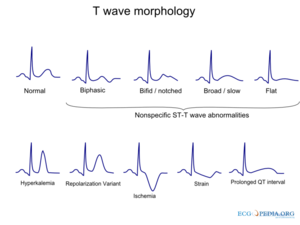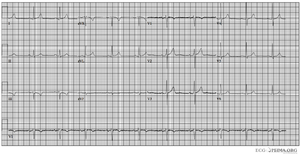We need you! Join our contributor community and become a WikEM editor through our open and transparent promotion process.
T wave changes
From WikEM
(Redirected from T wave)
Contents
Evaluation
- Normally upright in 1, 2, V3-V6
- Negative in AVR
- If is greater than 2/3 height of R wave then is abnormal
- Distribution
- T wave is normally inverted in aVR; sometimes inverted in III, aVF, aVL, V1
- T-wave inversions in V2-V6 are usually pathologic
- With the exception of persistent juvenile T-wave pattern, usually limited to V1-V3, classically young Afro-Caribbean women
- Morphology
- Inverted, symmetric,
- Transient changes suggests ischemia without infarction
- Persistent changes suggests infarction (troponin elevation usually seen)
- Pseudonormalization
- In presence of baseline TWI (within 1 month), reocclusion causes normalization of TWI
- Should be interpreted as evidence of ischemia
New Tall T-wave in V1[1]
- Loss of precordial T-wave balance when upright TW in V1 > upright TW in V6
- A form of hyperacute T-wave
- New Tall T-Wave in V1 (NTTV1) = upright T-wave in V1, especially with proven change from previous ECG
- Concerning for ischemia, especially with ACS symptomology
- Perform repeat ECGs
- Normal variants
Differential Diagnosis
T Wave Inversions
- Normal in pediatrics
- Myocardial infarct (NSTEMI)
- Myocardial ischemia (Wellen's) - T waves go up, then down
- Hypokalemia - T waves go down, then up (or camel humped, one upright TW and upright U-wave in severe hypokalemia)
- Hyperkalemia
- Pulmonary embolism (RV strain)
- Pulmonary hypertension, acute or chronic
- Pulmonary disease - hyperventilation, pneumothorax, pneumonia
- LVH with strain pattern
- RVH
- Bundle branch block (both left and right)
- WPW
- Pericarditis (stage 3)
- CNS T waves (diffuse, deep)
- Arrhythmogenic right ventricular dysplasia (may also have epsilon wave)
- HOCM
- Paced rhythm
- Elevated intracranial pressure
Peaked T-waves
- MI (hyperacute T waves)
- Hyperkalemia
- Benign Early Repolarization
- De Winter's T waves (acute LAD occlusion)
See Also
Sources
- ↑ Wagner GS and Strauss DG. Marriott's Practical Electrocardiography. LWW; Twelfth edition (December 18, 2013).



